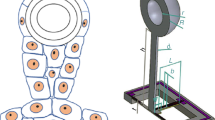Abstract
Majority of the sensors for underwater application use acoustic waves for detection, communication and navigation of submersibles. Hydrophone, used for sensing acoustic signals in water, has piezoelectric material within which responds to acoustic pressure by generating electric potential. Different types of hydrophones having different shapes can be manufactured depending on their applications. An omni-directional hydrophone can be developed using a spherical piezoelectric material as active material. This paper describes the design and development of a spherical hydrophone using lead zirconate titanate-4 (PZT-4) hollow sphere, having Receiving Sensitivity (RS) − 205 ± 0.6 dB ref 1 V/µPa in the frequency band 0–10 kHz. Analytical modelling of the piezoelectric sphere is done to fix its dimensions for the desired output and numerical analysis is done in COMSOL Multiphysics to validate the result. Since the spherical hydrophone is manufactured by encapsulating the piezoelectric sphere with polymer to give water-tight insulation, numerical analysis of the piezoelectric sphere coated with a polymer is done to calculate the RS of the hydrophone. Fabrication of a spherical hydrophone is done by rubber encapsulation of the piezoelectric sphere using compression moulding technique and its RS is measured in water. RS values obtained from numerical analysis and experiment are having a good agreement in the frequency band 0–10 kHz.













Similar content being viewed by others
References
Alkoy S, Hladky AC, Dogan A, Cochran JK Jr, Newnham RE (1999) Piezoelectric hollow spheres for microprobe hydrophones. Ferroelectrics 226(1):11–25
Alkoy S, Meyer RJ Jr, Hughes WJ, Cochran JK Jr, Newnham RE (2009) Design, performance and modeling of piezoceramic hollow-sphere microprobe hydrophones. Meas Sci Technol 20(9):095204
COMSOL (2020a) tutorial https://www.comsol.com/model/a-piezoceramic-tube-37. Accessed on 14–11–2019
COMSOL (2020b) tutorial https://www.comsol.com/model/spherical-piezoacoustic-transducer-6210. Accessed on 14–11–2019
George J, Ebenezer DD, Bhattacharyya SK (2010) Receiving sensitivity and transmitting voltage response of a fluid filled spherical piezoceramic transducer with an elastic coating. J Acoustical Soc Am 128(4):1712–1720
Guild MD, Haberman MR, Alu A (2011) Design of an ideal spherical hydrophone using a plasmonic acoustic cloak. J Acoustical Soc Am 129(4):2643–2643
Popov EP (1990) Engineering mechanics of solids. Prentice Hall
Stansfield D (1990) Underwater electroacoustic transducers: a handbook for users and designers. Bath University Press, Bath, p 27
Wang J, Qin L, Wei P, Tang L (2018) Modeling and analysis of multilayer piezoelectric-elastic spherical transducers. J Intell Mater SystStruct 29(11):2437–2455
Wilson OB (1988) Introduction to theory and design of sonar transducers, vol 3. Peninsula Publishing, Los Altos
Acknowledgements
The authors wish to express their sincere thanks to Director, NPOL and Director, DYSL-SM for carrying out the research and publish the work. The authors also wish to thank Mr. Linthish P, Mr Manoj Unni and Mrs A J Sujatha, members of transducer group of NPOL for their continuous support in fabrication and measurement.
Author information
Authors and Affiliations
Corresponding author
Additional information
Publisher's Note
Springer Nature remains neutral with regard to jurisdictional claims in published maps and institutional affiliations.
Rights and permissions
About this article
Cite this article
Ramachandran, V.P., Thomas, D. & Vinod, T.K. Design and development of a broadband spherical hydrophone using PZT-4. ISSS J Micro Smart Syst 9, 163–171 (2020). https://doi.org/10.1007/s41683-020-00063-0
Received:
Revised:
Accepted:
Published:
Issue Date:
DOI: https://doi.org/10.1007/s41683-020-00063-0




